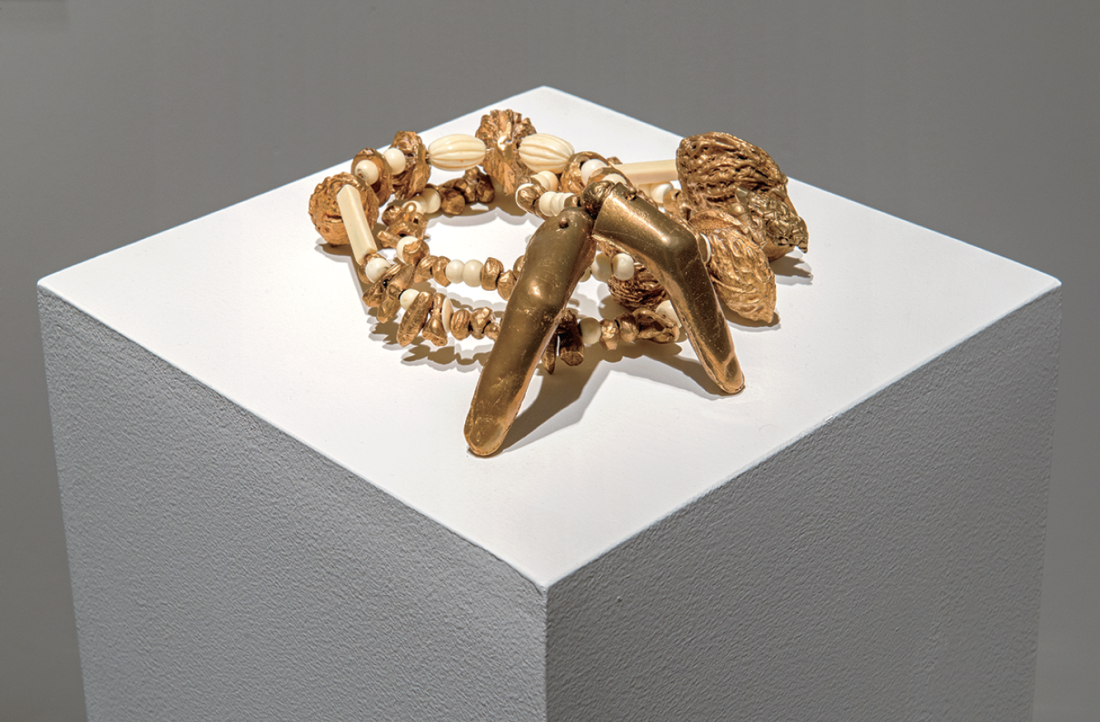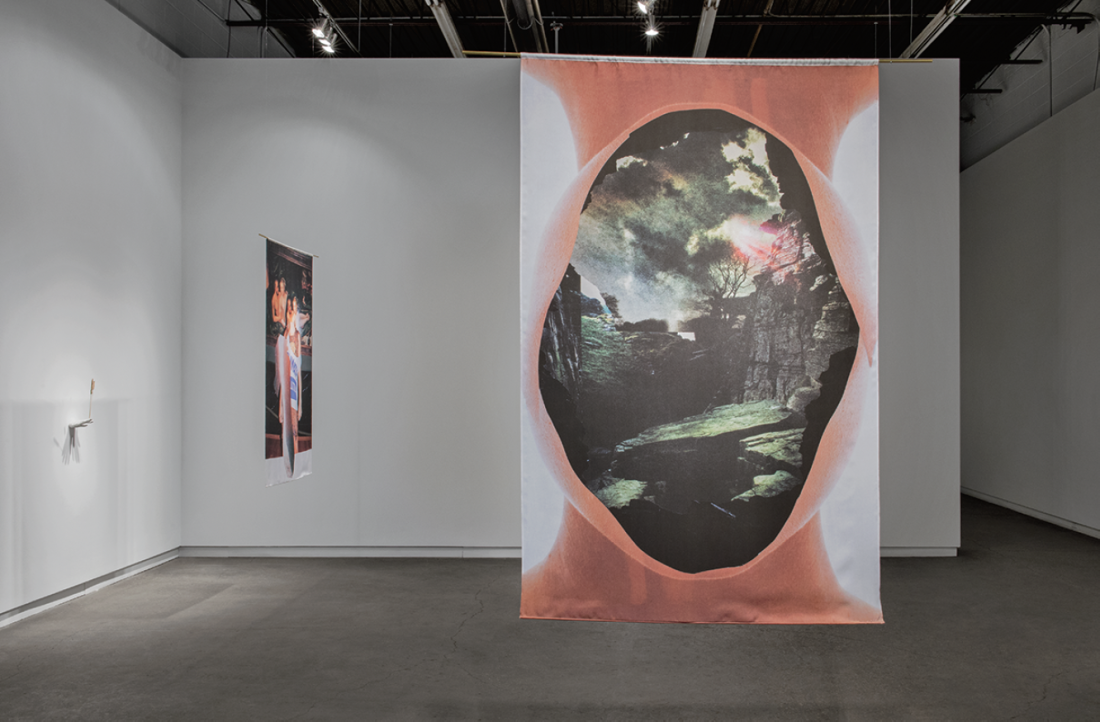Elizabeth Zvonar
One of the images in Elizabeth Zvonar’s latest exhibition, “The Challenge of Abstraction,” at Daniel Faria, Toronto is an edited Jürgen Teller photograph of Kate Moss standing in front of Albrecht Altdorfer’s Lot and his Daughter (1537). This collage is one of three images printed on translucent silk, hanging as banners from the ceiling. Aptly suited to its subject matter, the airy banner has the feel of clothing, specifically printed chiffon blouses. In this particular photograph, Moss is wearing a Vivienne Westwood “Climate Revolution” shirt overtop a luxury evening dress. The words “Climate Revolution” are obscured by a phallus-shaped abstract cut-out leaving only “mate” legible. Below the photograph is a white band, reminiscent of Photoshop layering, onto which the abstract shape descends. Part of the painting in the background has been cut out with what seems like the elliptical marquee tool, again in Photoshop, to obscure Moss’s face. Instead of her head we see a repeat of the leathery Lot leering at his daughter.
The reason for such a clinical description of the image, also called The Challenge of Abstraction, is that it functions as a visual synecdoche for the entire show by effectively combining the artist’s various formal strategies and social concerns. As a whole, the exhibition is a combination of collage printed on silk or paper as well as a variety of sculptures, both wall-mounted and on plinths. All the objects are tied together in their allusion to commodity. Zvonar sources from fashion and commercial photography in order to use the very strategies of seduction they employ. She merges images into new, often sexually suggestive configurations that in their rough-cut mixture of high and low have an edge not dissimilar to the aesthetics found in many independent publications or even the counter-culture-made-mainstream look of Vice Magazine, now the more sanitized Vice media. This overlap, or more aptly, reciprocal relationship, between counter culture and commerce is something with which Vivienne Westwood is also familiar. She is the British fashion designer largely responsible for bringing punk into high fashion. Indeed, the relationship between counter and mainstream culture is something art grapples with in its double position as luxury product and cultural artefact.

Elizabeth Zvonar, TINY DEVOTIONS, 2015, bronze, antique ivory, 9 x 8 x 3 inches.
The show is interesting in light of the previous Valérie Blass exhibition which also focussed on commerce, desire and the female subject/object. Though where Blass’s fragmented figures were often reflecting upon themselves literally indicated by the presence of mirrors, Zvonar’s allegory of desire is somewhat more straightforward. Weaving through the sparsely hung banners and theatrically-lit plinths feels like being in an upscale boutique whose minimal aesthetic emulates the art gallery. In Zvonar’s show, the tropes of the desire for consumption are most explicitly illustrated on the back wall where a print-out of plush, pink, slightly parted woman’s lips hangs above a thin, white plinth. Atop the plinth sits an aggregate of concrete lumps that resemble from afar an acorn or a vessel. Close up, you see what looks like little bits of dried organic debris poking out from the cluster of concrete, making the luxury item resemble something closer to shit. Titled NUTSACK, 2015, the little hairy bits are actually remnants of pantyhose used during the casting of a bag of mixed nuts. The commentary is cheeky though it’s unclear whether it remains consistent throughout the show.
While installing the show, Zvonar burned incense inserted into a number of her small sculptural pieces and into an image of an especially phallic geological feature. The partially burned sticks remain in the exhibition and their scent is, at times, faintly detectable. According to the curatorial statement, the incense is “a specifically commissioned west coast scent” whose presence is meant to reinforce “the sacrosanct relationship of the meditative ritual of arrangement.” The words “ritual,” “invisible” and “metaphysical” appear throughout the text and bear various degrees of relevance to Zvonar’s work. It’s true that art has long had a relationship to religion and some of the art historical references in the show speak to that, but the visual vocabulary and its presentation speak still more strongly to commodity. The smell of incense, in a secular Western culture, is also associated with stores selling “exotic” goods, or head shops—another aspect of counterculture made mainstream. If any physical transcendence is occurring here, it seems more intimately connected to the digital, rather than the metaphysical, realm. Digital transcendence is not without its interesting points, however. In fact it’s a topic that can be fleshed out in numerous ways, one of which is through the simultaneity of all information that in its database format is rendered equal. All images are classified according to algorithm rather than value, and in their dissemination via mediums like Instagram and Tumblr, seem strangely contemporary again. My first paragraph was written by inserting Zvonar’s work into Google image search, then cutting out parts of the image and, in turn, searching for those. I was led to consider the afterlife of the image when it appeared on a computer screen organized through resemblance rather than genre or subject or time. While Zvonar limits her sources and makes many of her collages by hand, there are distinct elements of the digital in her work, starting from the very fact that her collages are scanned and reprinted at a larger scale. Perhaps the translucent silk images allude to this dematerialization even as they position themselves as seductive advertisements.
Zvonar’s images never stray far enough from their sources to shed the now familiar ambience of counterculture-infused advertising and the cross-chronological breadth of database searches. If Zvonar’s images remain advertisements, they can only advertise themselves and the cultural cachet involved in the purchase of art. They do this successfully; they are very seductive and easily draw in the gaze. They tap into that space that makes the margin palatable to a larger audience in much the same way Vivienne Westwood and Vice media have. Luxury, commodity and art object seamlessly interweave, rendering the work powerful in the way expensive objects are, and simultaneously, curiously benign. ❚

Elizabeth Zvonar, installation view, “THE CHALLENGE OF ABSTRACTION,” 2015, Daniel Faria Gallery. All images courtesy Daniel Faria Gallery, Toronto.
“The Challenge of Abstraction” was exhibited at the Daniel Faria Gallery, Toronto from May 2 to June 6, 2015.
Dagmara Genda is an artist and freelance writer living in Guelph.

